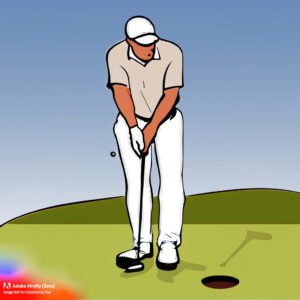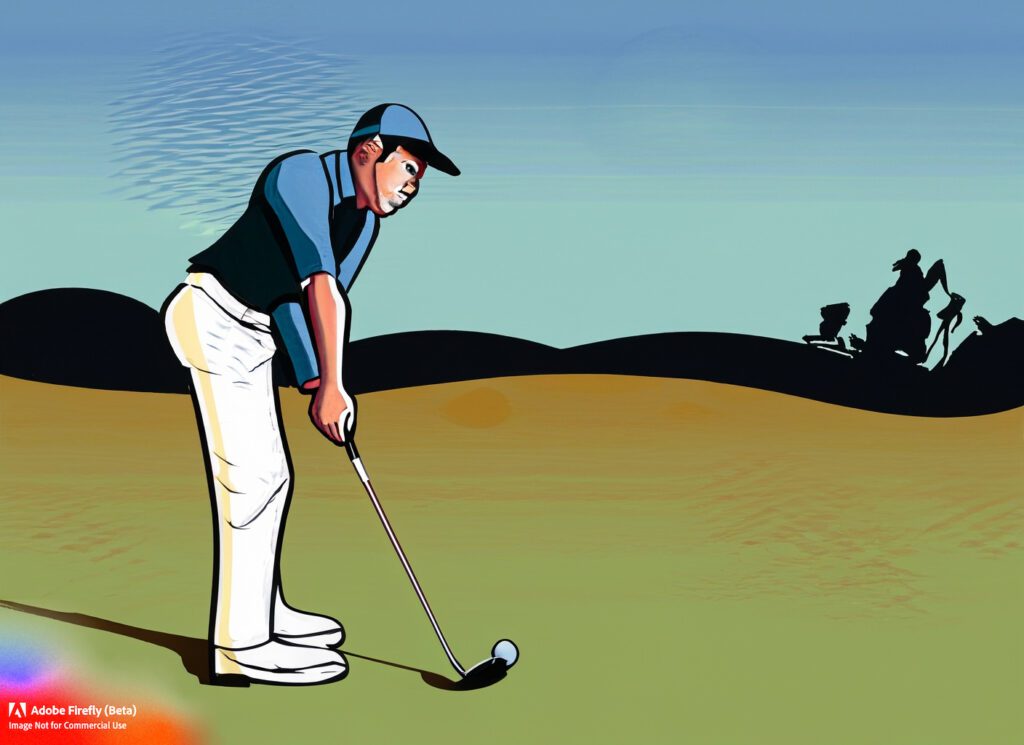Golf is a beloved sport that has been enjoyed by people around the world for centuries. It is often considered one of the most challenging sports, requiring precise technique, mental focus, and strategic thinking. In this article, we will explore why golf is the hardest sport and the various challenges and skills required to excel in the game.
Why Golf is Considered the Hardest Sport
Golf is often considered the hardest sport for several reasons:
1. Precision: Golf requires extreme precision and accuracy in every aspect of the game. From tee shots to approach shots and putting, golfers must carefully gauge distance, direction, and speed to achieve the desired outcome. The small size of the golf ball and the vastness of the golf course make precision an essential skill.
2. Mental Focus: Concentration and mental fortitude play a crucial role in golf. Golfers must maintain focus throughout a round, staying calm and composed even after a bad shot. The mental aspect of the game can be challenging, as golfers must make critical decisions, handle pressure, and stay in the present moment.
3. Consistency: Golf is a game of consistency, where success is measured over the course of 18 holes. Unlike team sports that allow for occasional mistakes, golf requires players to consistently perform at a high level. Each swing must be executed with precision, and any lapse in technique can result in poor shots and lost strokes.
The Challenges and Skills Required in Golf
To excel in golf, players must develop a wide range of skills and overcome various challenges:
- Driving Accuracy: Hitting the fairway off the tee is crucial in golf. Players must develop a consistent swing that allows them to keep the ball in play and avoid hazards. Driving accuracy requires a combination of technique, timing, and power.
- Iron Play: Approach shots with irons require precise distance control and accuracy. Golfers must choose the correct club, factor in wind and course conditions, and execute the shot with precision to set up scoring opportunities.
- Short Game: The short game includes shots around the green, such as bunker shots, chip shots, and putting. Golfers must have a delicate touch, feel, and creativity to navigate different lies and slopes, and make the ball stop close to the hole.
- Mental Resilience: Golf is a mentally demanding sport that requires resilience and the ability to rebound from mistakes. Golfers must stay focused, maintain confidence, and manage their emotions, especially during high-pressure situations.
Mastering these skills and overcoming the challenges of golf takes time, practice, and dedication. However, the rewards of a well-struck shot, a perfectly rolled putt, and the satisfaction of improving make the journey worthwhile.
In conclusion, golf is considered the hardest sport due to its precision, mental demands, and the consistency required to succeed. Golfers must develop a wide range of skills and overcome various challenges to excel in the game. Despite its difficulties, golf offers a unique and fulfilling experience that keeps players coming back for more.
RELATED: How Long Do Golf Gloves Last?
Precision and Skill

The Importance of Accuracy in Golf
When it comes to sports that require precision and skill, golf is often considered one of the most challenging. Golfers face a unique set of challenges that make the sport incredibly difficult to master. Here are some reasons why golf is often regarded as one of the hardest sports:
Golf requires precise control and accuracy: Unlike other sports where athletes rely on speed and strength, golf revolves around the player’s ability to control and accurately strike the ball. The slightest error in alignment or swing can result in a missed shot or an unfavorable position on the fairway.
Variable landscapes and weather conditions: Golf courses are known for their diverse landscapes, which can include sand traps, water hazards, and undulating greens. Each hole presents a new challenge that requires golfers to adapt their strategy and make precise shots. Additionally, weather conditions such as wind and rain can further complicate the game and require adjustments in technique.
The mental game: Golf is often referred to as a mental game, as players must maintain focus and composure throughout the entire round. The pressure to perform well, the strategic decision-making, and the ability to stay calm under pressure can greatly impact a golfer’s performance. Mental strength and concentration are essential qualities for success in golf.
Mastering the Perfect Swing
One of the key aspects of golf that adds to its difficulty is mastering the perfect swing. The golf swing is a complex movement that requires a combination of coordination, balance, and timing. Here are some factors that make the golf swing particularly challenging:
Body mechanics: The golf swing involves a sequence of movements that require precise coordination between the upper body (including the arms and hands) and the lower body. Proper alignment, posture, and positioning of the various body parts are crucial for generating power and achieving accuracy.
The relationship between club and ball: Golfers must develop a deep understanding of how different clubs and ball interactions produce different outcomes. Factors such as clubhead speed, clubface angle, and ball spin all affect the trajectory and distance of the shot.
Consistency and muscle memory: Unlike many other sports, where athletes perform repetitive actions with minimal variation, golfers must adapt their swing to various distances, terrains, and shot types. Developing muscle memory through practice and repetition is crucial for maintaining consistency in the swing.
Mastering the perfect swing requires a combination of physical ability, technical expertise, and mental focus. It takes years of practice and dedication to achieve the level of skill required to excel in golf.
Overall, golf is often considered one of the hardest sports due to the precision and skill required, the variable landscapes and weather conditions, and the mental challenges that players face. It is a sport that demands not only physical prowess but also strategic thinking and mental discipline. Whether you’re a seasoned golfer or a beginner, golf offers a lifelong challenge and an opportunity for personal growth.
Mental Toughness
Golf is not only physically demanding but also mentally challenging. The nature of the sport requires players to remain calm, focused, and confident throughout the game. Here are some reasons why golf is considered one of the hardest sports in terms of mental toughness.
The Psychological Challenges of Golf
1. Self-Doubt: Golfers often face self-doubt, which can negatively impact their performance. The long hours of practice and high expectations can lead to doubts about one’s abilities, making it challenging to stay positive and focused during a game.
2. Perfectionism: Golf requires precision and accuracy, and the pursuit of perfection can put tremendous pressure on golfers. A single mistake or poor shot can lead to frustration and self-criticism, affecting subsequent shots and overall performance.
Managing Pressure and Focus on the Course
1. Focus and Concentration: Golf requires intense focus and concentration for extended periods. Golfers need to maintain mental clarity to analyze the course, control their swing, and make strategic decisions. Distractions and maintaining focus under pressure can be extremely challenging.
2. Managing Pressure: Golfers often face intense pressure, especially during competitive tournaments. They must perform well under pressure and manage their emotions effectively. The ability to handle pressure situations with composure and make critical shots is crucial in golf.
3. Patience and Resilience: Golf is a game of highs and lows, and golfers must have the patience to handle setbacks and stay motivated. It can be mentally challenging to maintain composure and bounce back from a bad shot or a string of poor holes.
Golfers who excel in the sport understand the importance of mental toughness and develop strategies to overcome psychological challenges. Techniques such as visualization, positive self-talk, and mindfulness can help golfers stay mentally strong on the course.
In conclusion, the mental demands of golf contribute to its reputation as one of the hardest sports to master. Golfers must work on their mental game, develop mental toughness, and learn to manage pressure and maintain focus to excel in this challenging yet rewarding sport.
Variables and Environment
When it comes to the difficulty of a sport, the variables and environment play a crucial role in determining the level of challenge. Golf is no exception, and in fact, it is often considered one of the hardest sports due to the impact of weather and course conditions on the game.
The Impact of Weather and Course Conditions
One of the biggest challenges in golf is the unpredictable nature of weather and its effect on the course conditions. Here are some factors that can make golf particularly challenging:
1. Weather Conditions: Golf is played in all types of weather, from scorching heat to heavy rain and windy conditions. Weather can greatly affect the trajectory and distance of the ball, making it difficult for players to maintain consistency.
2. Course Design: Golf courses are designed to provide a variety of challenges. From undulating fairways to strategically placed bunkers and water hazards, each hole presents its own unique set of challenges that players must navigate.
3. Green Speed and Slope: The speed and slope of the greens can significantly impact putting. Faster greens require more precision and delicate touch, while sloping greens can make it challenging to read the breaks and accurately judge the speed of the putt.
Adapting to Different Courses and Challenges
Another aspect that makes golf a difficult sport is the need to adapt to different courses and their specific challenges. Here are some factors that players need to consider when playing on different courses:
1. Course Length: Golf courses vary in length, which affects the strategy and club selection for each shot. Longer courses require more distance and accuracy, while shorter courses may demand more precision and finesse.
2. Course Hazards: Hazards such as bunkers, water hazards, and roughs pose additional challenges that players need to navigate. Avoiding these hazards and making strategic shot choices adds complexity to the game.
3. Course Topography: The terrain and elevation changes on a golf course can have a significant impact on shot selection and execution. Uphill and downhill shots require adjustments in club choice and swing technique.
In conclusion, golf is often regarded as one of the hardest sports due to the variables and environment it presents. The impact of weather and course conditions, as well as the need to adapt to different courses and challenges, add to the complexity and difficulty of the game. It is these factors that make golf a true test of skill, precision, and mental fortitude.
RELATED: Golf Cart Fuse Box Location- [Find & Replace]
Strategy and Decision-Making
When it comes to sports, golf stands out as one of the hardest. It requires a unique combination of physical skills, mental fortitude, and strategic thinking. The game of golf is not just about driving the ball long distances or putting it into the hole; it also involves making smart decisions on the course that can greatly impact your overall score. Here are some key aspects of strategy and decision-making in golf:
The Strategic Thinking Required in Golf
Golf is often referred to as a game of chess played on a field. It requires players to think strategically and plan their shots carefully. Here are some key considerations when developing a strategy in golf:
- Course Management: Understanding the layout and features of the course is essential for success in golf. Analyzing the distances, hazards, and potential bottlenecks can help a player develop a strategy that maximizes their chances of success.
- Club Selection: Golfers must decide which club to use for each shot, considering factors such as distance, wind direction, and the lie of the ball. Making the right club selection can greatly impact the outcome of a shot.
- Risk vs. Reward: Golfers often face situations where taking a risky shot could potentially yield a great reward. However, it also comes with the risk of incurring penalties or hitting the ball into a difficult position. Balancing risk and reward is a constant challenge in golf.
Reading the Course and Making the Right Decisions

In addition to strategic thinking, golfers must also make split-second decisions while on the course. Here are some key factors that golfers must consider when making decisions:
- Slope and Green Reading: Determining the slope and break of a green is critical for making accurate putts. Reading the course and making the right adjustments in speed and direction can be challenging and requires both practice and experience.
- Shot Selection: Golfers must make decisions about shot shape (fade, draw, etc.), trajectory, and shot type (chip, pitch, full swing). Different situations call for different shots, and choosing the right one can greatly impact the outcome.
- Weather Conditions: Golfers must also consider the weather conditions, such as wind direction and speed, when making decisions on the course. These factors can greatly affect the flight of the ball and require adjustments in strategy and shot selection.
Overall, golf is considered one of the hardest sports because it requires not only physical skill but also mental acuity and strategic thinking. Golfers must analyze the course, make smart decisions, and execute their shots with precision. It is a challenging sport that demands continuous improvement and a deep understanding of the game.
Practice and Mastery
The Time and Effort Needed to Excel in Golf
Golf is often considered one of the most challenging sports to master, and it’s not without reason. The game requires a significant amount of time, effort, and dedication to excel. Here are some reasons why golf is often viewed as the hardest sport to play:
1. Technical Skill: Golf involves a complex set of physical skills, including proper grip, stance, swing, and coordination. Mastering these technical aspects requires hours of practice and repetition.
2. Mental Agility: Golf is a mentally demanding sport, requiring excellent focus, concentration, and decision-making skills. Golfers must continuously analyze the course, adjust their strategies, and make split-second decisions.
3. Precision and Accuracy: Unlike other sports where athleticism and physicality play a significant role, golf demands precise and accurate movements. A slight miscalibration in the swing or clubface angle can result in a wayward shot.
The Importance of Consistent Practice and Improvement
To excel in golf, consistent practice and improvement are vital. Here’s why:
1. Muscle Memory Development: Golf requires developing muscle memory to achieve consistent and repeatable swings. Regular practice aids in honing this muscle memory, leading to improved accuracy and control.
2. Understanding Course Conditions: Golf involves adapting to different course conditions, such as wind, slope, and grass length. Regular play and practice allow golfers to become familiar with these conditions and make adjustments accordingly.
3. Mental Resilience: Golf can be a game of highs and lows, and mental resilience is crucial. Consistent practice helps golfers develop resilience, enabling them to overcome challenging situations and stay focused on their game.
By consistently practicing and seeking improvement, golfers can gradually refine their skills and achieve success on the course. It’s a sport that values patience, dedication, and a growth mindset.
So, if you’re up for the challenge, grab your clubs, head to the driving range, and embrace the journey to mastering this beloved and demanding sport.
Physical Demands
Golf is often perceived as a leisurely sport that doesn’t require much physical exertion. However, the truth is that golf can be one of the most physically demanding sports out there. This section explores the physical fitness requirements in golf and why it is considered to be one of the hardest sports.
Golf requires a combination of strength, flexibility, and endurance to perform at a high level. Here are some of the physical demands of the sport:
1. Core Strength: The core muscles, including the abdominals, back, and hips, play a vital role in generating power and stability in the golf swing. A strong core helps maintain balance and transfer energy efficiently from the upper to the lower body.
2. Flexibility: Golfers need a high level of flexibility to achieve a full range of motion in the golf swing. Flexibility allows for a fluid and effortless swing, reducing the risk of injuries and improving performance.
3. Endurance: Golf may not involve constant running or jumping, but it requires a significant amount of endurance. A typical round of golf can last several hours, and players need to maintain focus, concentration, and physical stamina throughout the entire game.
So, the next time you see someone teeing off on the golf course, remember that behind that seemingly effortless swing lies a great deal of physical fitness and athleticism. Golf truly is one of the hardest sports out there!
Conclusion -Why Golf Is The Hardest Sport
In conclusion, golf is often considered one of the hardest sports for several reasons. Its unique combination of physical and mental skills, the precision required for every shot, and the challenging nature of the courses all contribute to its difficulty level. Despite its challenges, golf offers a rewarding experience for those who are willing to put in the time and effort to improve their game. Here are some key reasons why golf remains a challenging and rewarding sport:
- Technical Skill: Golf requires a high level of technical skill, including proper swing mechanics, club selection, and shot strategy. These skills take years of practice and refinement to master.
- Mental Focus: Golf is as much a mental game as it is a physical one. Players need to stay focused and composed, managing pressure and making strategic decisions throughout the round.
- Course Management: Golf courses are meticulously designed with various hazards, bunkers, and water bodies strategically placed to challenge players. Navigating the course and making smart decisions are essential for a successful round.
- Consistency: Golf requires consistent performance across all aspects of the game, including driving, iron play, chipping, and putting. Maintaining consistency over 18 holes is a significant challenge.
Key Takeaways and Lessons from Golf’s Difficulty
Despite the difficulties, golf offers valuable lessons and skills that can be applied to other areas of life:
- Persistence: Golf teaches patience and persistence, as improvement often comes gradually over time.
- Focus and Concentration: Golf requires players to stay fully present and focused on each shot, enhancing concentration skills.
- Problem-solving: Golf challenges players to strategize and problem-solve, finding the best approach to navigate the course and overcome obstacles.
FAQ
Q: Is golf harder than other sports?
A: Golf’s unique challenges make it difficult in its own way, but comparing it to other sports is subjective. Different sports require different skills and abilities.
Q: Can anyone learn to play golf?
A: Yes, anyone can learn to play golf with proper instruction, practice, and dedication.
My Personal Experience
As a passionate golfer, I have experienced firsthand the challenges and rewards of the sport. The constant pursuit of improvement, the thrill of hitting a great shot, and the camaraderie with fellow golfers make it a sport like no other. Despite its difficulty, golf has provided me with valuable life lessons and unforgettable experiences on the course. I encourage anyone interested in golf to give it a try and discover the joys and challenges it has to offer.

I’m Donna Weiss, and I am the proud writer behind the captivating content you’ll find on golfneedy.com. As an avid golfer and passionate writer, I have combined my two greatest passions to bring you an incredible golfing experience. Through my articles, I aim to provide you with valuable insights, equipment reviews, and updates on the latest tournaments. Whether you’re a seasoned golfer or just starting out on this exciting journey, I am here to guide you and share my expertise. Together, let’s explore the fascinating world of golf, uncovering new techniques, and enhancing our skills. Join me on this thrilling adventure as we elevate our game and embark on an exciting golfing journey. Read More



